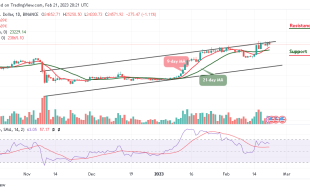Join Our Telegram channel to stay up to date on breaking news coverage
Stablecoins are now in the SEC’s focus. For failing to register the product as a security, it purportedly intends to sue Paxos, a blockchain service provider that manages the third-largest stablecoin BUSD. Paxos was also told to stop trading the coin.
It’s another setback for the unpredictable cryptocurrency market. Although no official action has been taken, if the SEC has stablecoins in its sights, the cryptocurrency landscape may undergo a significant change.
In spite of everything, the price of stablecoins and the overall crypto market will continue to rise in 2023. Below, we discuss the specifics.
The newest crypto target of the SEC
The SEC, a federal regulator, issued a Wells notice to Paxos, a blockchain infrastructure platform, at the beginning of February, signaling that an investigation may lead to charges. The company is selling an unregistered security with its BUSD stablecoin, according to the SEC.
Moreover, the New York regulator ordered Paxos to halt releasing BUSD, the stablecoin supported by Binance. According to the New York Department of Financial Services (NYDFS):
[The order was] a result of multiple outstanding problems pertaining to Paxos’ management of its connection with Binance.
Changpeng Zhao, the creator of Binance, announced the news on Twitter.
#BUSD. A thread. 1/8
In summary, BUSD is issued and redeemed by Paxos. And funds are #SAFU!
— CZ 🔶 BNB (@cz_binance) February 13, 2023
Because BUSD is not a security under federal securities laws, Paxos stated that it “categorically disagrees with the SEC staff” and was ready to “vigorously defend if necessary.”
As of January 31, there were approximately $16 billion in holdings in Paxos’ BUSD product, which is separate from Binance’s own BUSD stablecoin and is constructed on the Ethereum blockchain. With Binance and Paxos’ initial partnership in 2019, it has been available on the market.
The drama could get worse shortly. Paxos may face legal action from the SEC for breaking investor protection regulations, which might be a turning point in the fight against regulators for cryptocurrencies.
Regulation, securities, and stablecoins
According to Paxos’ statement:
Whether the BUSD stablecoin is a security is the crux of the argument. BUSD is always backed 1:1 with U.S. dollar-denominated reserves, properly separated and maintained in bankruptcy distant accounts.
After the demise of cryptocurrency darling FTX, U.S. regulators have been on high alert with regard to crypto firms, and this month has been active for slapping the whip.
The NYDFS accused Coinbase of having compliance issues, claiming that its AML and know-your-customer requirements were subpar and that it did not adequately verify new consumers. In January, Coinbase reached a settlement for $100 million.
Genesis Global Trading, a provider of digital assets, and Gemini, a New York-based cryptocurrency exchange, have come under fire for allegedly selling unregistered securities as part of their joint financing program. Each company disputes the allegations.
After being accused of failing to register the plan with the SEC, cryptocurrency exchange Kraken also consented to pay $30m in fines and shut down its crypto staking-as-a-service business.
What has happened to the market?
Investors have fled the area ever since February 13 when Paxos released its announcement. Its BUSD stablecoin’s market cap has dropped from $16.1 to $12.9 billion, and Changpeng Zhao predicted that this decline will continue.
The confusion has been advantageous for other stablecoins. The market leader in stablecoins, Tether (USDT), has increased its domination to $70.3bn, cornering over 53% of the market. The Dollar coin issued by rival Circle now has a market share of 31.3% and a value of $42 billion.
Despite the crackdowns, cryptocurrency values are rising, with BitcoinBTC -2.9% prices reaching highs of $25,000 and ordinary investors returning.
Since the Paxos scandal, the stablecoin market has increased by $2 billion, and Tether is now unquestionably in the lead. So how long can stablecoins survive in their current form with the SEC at their backs?
What are the consequences for the world of cryptocurrency?
The “safer” segment of the cryptocurrency market is supposed to be stablecoins. They are backed by short-term assets such as U.S. Treasuries and Treasury Reverse Repurchase Agreements, allowing anyone owning the currency to swap it at any time 1:1 for USD.
In the face of scandals, fraud, and criminal activity, they have quickly established themselves as the core of the cryptocurrency market due to their considerable security against volatility. But if the SEC investigates every possibility, the cryptocurrency landscape might change.
Following FTX, the American financial regulators came under fire for allegedly moving too slowly to take action against unethical actors in the sector. Additionally, it needs to be understood as acting in response to the Biden administration’s publication on reducing cryptocurrency risks at the end of January, which makes two mentions of stablecoins.
The Paxos case has elicited conflicting responses from the cryptocurrency community, with some criticizing the SEC’s enforcement action. It’s important to note that the SEC has experienced internal opposition; SEC Commissioner Hester Pierce questioned the decision of the Kraken case and claimed that the SEC had terminated a “program that has benefited people well.”
What about American digital money?
Cynics will also point out that the SEC’s crypto crackdown comes as the Fed’s digital currency initiative is building up.
The Fed’s Project Cedar is a blockchain-based central bank digital currency (CBDC) prototype. While there are no specifics on when the currency will be made available, stage one testing has already been finished.
It’s not the only nation developing a digital version of its national money. Similar progress has been made recently by the Bank of England, European Central Bank, and Bank of Japan; the latter intends to launch its pilot program as early as April.
The cryptocurrency market might directly compete with centralized digital currencies. Despite the volatility, the industry is full with shady characters, but retail investors have been drawn in by its commitment to customer privacy.
What we might observe is a conflict between two types of digital currencies: one controlled by banks and the other not under their control.
The conclusion
To avoid coming off as overly relaxed in the face of FTX, the SEC is far from finished with its crusade to regulate the cryptocurrency industry.
While we wait to see how Paxos’s run-in with the regulator plays out, other stablecoins like Tether and Circle continue to draw interest from investors and expand their market share.
After a bad year, cryptocurrency is starting to recover. Q.ai’s Crypto Kit can help if you want to invest but don’t know where to begin. With our AI doing its magic to provide you the optimum risk and reward for your portfolio, it invests through a regulated trust.
Related
- U.S. Government Takes A Round Of Moves To Clamp Down On The Crypto Sectors
- Operation Choke Point 2.0: US goes after crypto amid confusion and uncertainty
- White House: Crypto Regulation Drama
Join Our Telegram channel to stay up to date on breaking news coverage


